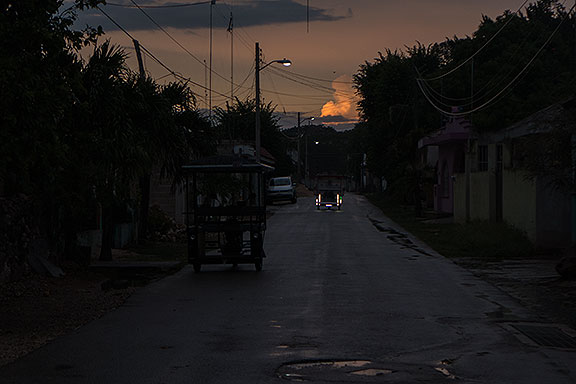
Moto-trikes at sunset after big tropical downpour, Teabo, Yucatan, Mexico.
Sitting in Mérida, Yucatan, munching on the irresistible marzipan candies that are available everywhere here. Came down for a family wedding, and stayed to join a community delegation to support the Luis Gongora Pat family in their efforts to generate local awareness about the case, and hoping to pressure the Mexican government to, in turn, pressure the U.S. and San Francisco District Attorney to prosecute the police who murdered Luis on Shotwell Street about 4 months ago. On November 1st, we travelled to celebrate the Hanal Pixán festival, feast for the spirits as part of the Day of the Dead days. November 2nd is Day of the Dead, or All Soul’s Day.
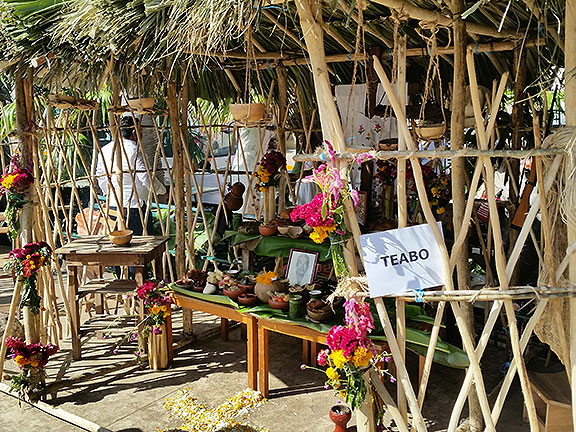
The town of Teabo put up an altar in Mérida’s central square for the Hanal Pixán celebration
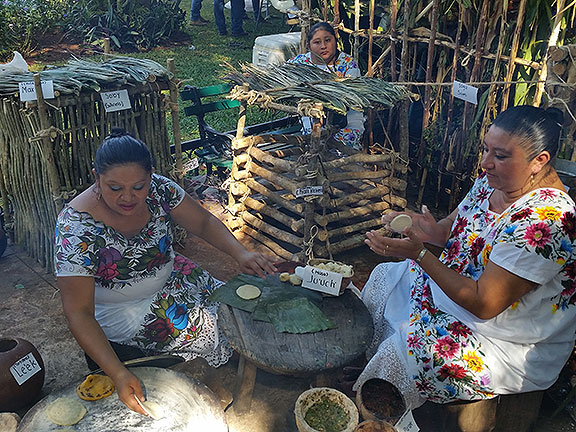
Dozens of altars filled the square, many of them with labels in Mayan to help celebrants learn how things are named.
I should quickly note that I haven’t written much lately and haven’t posted a thing since the end of my summer in Mexico City. Why, my millions of readers want to know? Well, returning to San Francisco turned out to be more jarring than I had previously experienced, or ever would have expected. I felt pretty dislocated from my own life for more than a month before getting back in the flow.
I know perfectly well that the soul of the city has been draining away. It’s like someone pulled the plug a few years ago and now the bathtub is practically empty, the last murky waters circling the drain as we see what made many of us feel so strongly about San Francisco disappear in the last swirls into the void. It was also true that I loved being in Mexico City, a big vibrant city with lots of history and countless places to explore. And finally I was beginning to enjoy some real communication in Spanish after being blocked by my shame at bad speaking for so many years. Returning to SF from Mexico City was a bit of a letdown, given that San Francisco is very small and relatively provincial compared to a true world city, and its history that I know so well pales in comparison to places like Mexico City or other places with centuries behind them. (Not that I don’t still love local history, I do. And I’m fully engaged with Shaping San Francisco to this day and have no plans to stop.)
I also returned to the quadrennial madness that passes for democracy here. It’s a completely shameful spectacle that has so little to do with what we are actually facing, whether locally, statewide, nationally, or internationally. I inevitably find it terribly depressing to see so many of my intelligent friends become unhinged on cue during this process of mass hysteria known as the Presidential election. Spare me the lectures about how awful Trump is. I know. Or how awful Clinton is, I know. Or how the differences between them are SO important. There have certainly been some artfully concocted campaigns to create that impression. And I generally believe there are much greater differences between these two than we’ve seen in past elections, and that a Trump victory would (and to some extent already has) “unleash the beast in White America,” as a KPFA commentator put it a month ago. But I also still think that even though the narcissistic windbag has blown up the GOP with his campaign, there is a tight consensus in the American ruling class about the role of the U.S. military in world affairs, the inviolability of private property and wage-labor, and the basic structure of life that has benefited their class so handsomely. Neither candidate is going to challenge the hegemony of banks, oil, or the war economy. Neither candidate is going to address climate change, dismantle the car-centric physical structure of life, reorganize the plumbing in every house to accommodate gray water and composting, develop urban organic agriculture as an alternative to the endless proliferation of bullshit jobs, or replace the absurdity of GNP and endless growth with a new logic based on a good life for all, a stable state circular economy, and less work! My idea of what is necessary and urgent doesn’t even enter the conversation. And it depresses me deeply to realize that what I’m arguing for is considered so far beyond the pale that it is simply laughed away as improbably unrealistic. I’d say my very scratch-the-surface list above is much closer to a basic realism than any of the capitalist utopians promising a better future based on the broken logic of the ways things are.
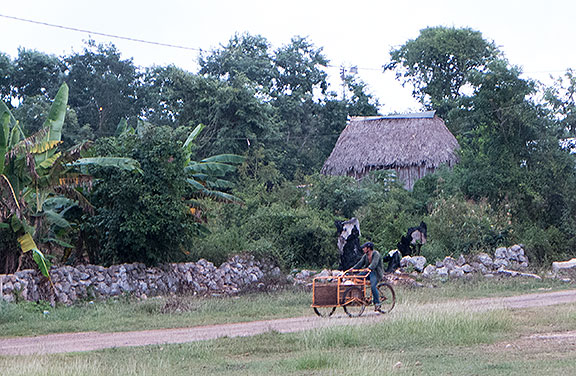
Teabo, Yucatan, outskirts. The term “Pueblo Biciclitero” is used derogatorily against small towns in Mexico to indicate their backwardness… but in the Yucatan a huge number of people use bicycles regularly and it is clear evidence of an advanced way of living!
Anyway, I came to Mexico for a week, and it’s a relief to get away from the incessant yammering and overwhelming tidal wave of bullshit that passes for democratic debate in the United States. If this isn’t evidence of a collapsing society I don’t know what is!
Yesterday I had the honor of accompanying Adriana, along with Tiny of Poor Magazine and her son Tiburcio, to the town of Teabo, about an hour and a half southeast of Mérida, the hometown of Luis Gongora Pat, and his brothers and cousins and their extended families that we’ve come to know in San Francisco. We were greeted by Luis’s daughter Rossana, his niece Viki and his cousin Teresa who brought us to the family home a couple of blocks from the church in the central plaza. There we met the parents, wife, sisters-in-law, nieces, nephews and grandkids, a lovely and resilient group in which the women stand tall and are clearly the pillars of family life here, with the men away working in the US and Merida… and Luis killed.

The Gongora women with Adriana and Tiny after visiting the cemetery.
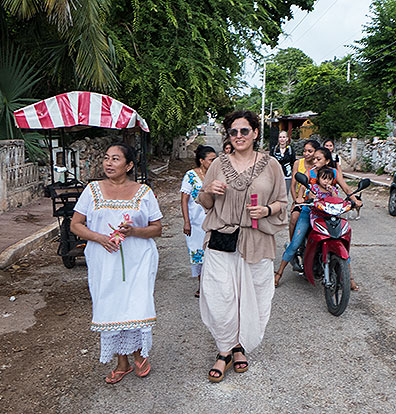
And on the way, a bit earlier.
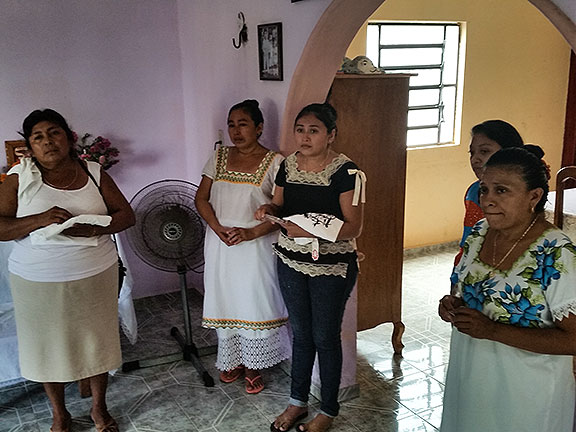
We gathered in their home on our arrival and got to know one another a bit.
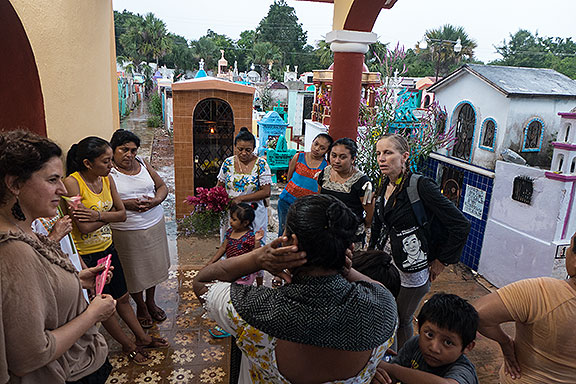
Later, at the cemetery when the heavy rains came, we stood under the capela chatting with neighbors.
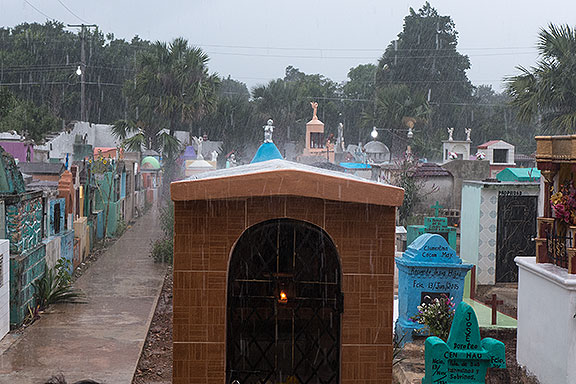
It rained like hell!
This was one of the most interesting parts of the experience. Clearly the women at the center of family life here in Teabo have enormous dignity and strength and have created a family life with each other in spite of the dislocation caused by the absence of the men who left. They live on a multi-family plot of land with two relatively modern homes built with remittances sent back by the husbands we know in San Francisco (who have been there for 10-25 years, sending back parts of their wages every month). But this experience is far from unique to this family. This is a common story all over Mexico, and the global south. “Globalization” has sent people hurtling through frontiers legally or illegally across the planet, dislocating individuals, families, industries, and ways of life. In many parts of the global south the men (especially, though not exclusively) migrate north to the U.S. or Europe in search of higher wages and a better life for their family. The family, now headed by the women left behind, finds a way to thrive in their absence thanks in part to the money they send back. Modernization and upgrades to family homes takes place over years, while in the case of this family in Teabo, the parents still have their traditional thatched roof huts in the shared open land behind the houses, where turkeys are kept in a pen, a big male pig has its own sty where he sires new litters regularly, and chickens have the run of the yard too. We ate a wonderful stew Pavo en Escabeche made with pavo de patio (Turkey from the yard), consisting of a turkey slaughtered earlier in the day.
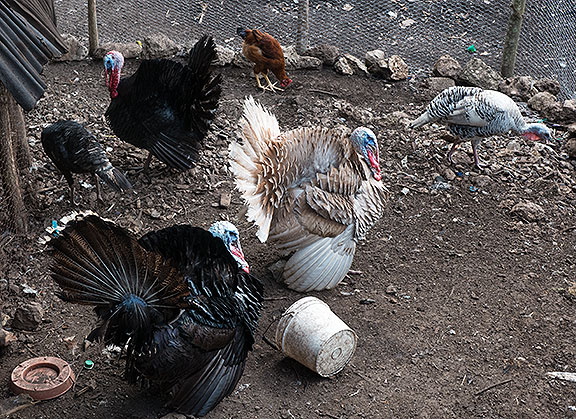
Gorgeous turkeys in the yard
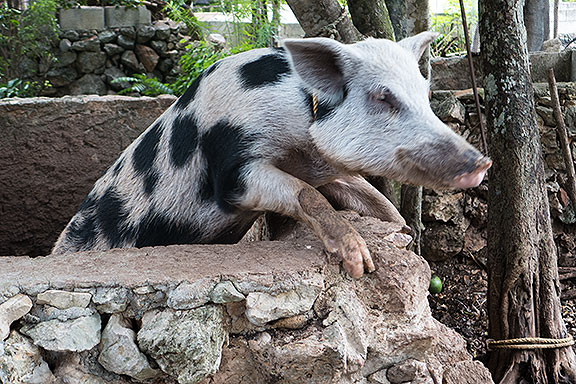
And a very friendly pig!
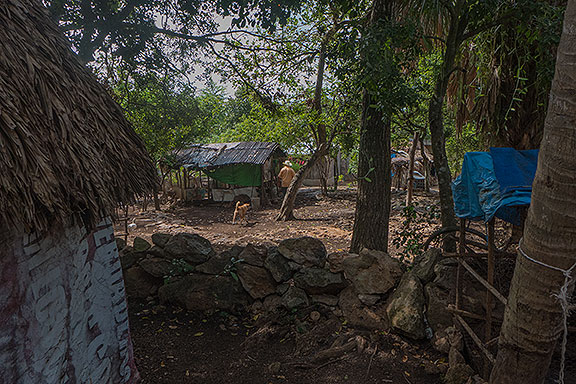
The back yard… part of it anyway!
Later when we walked to the cemetery and back we saw many neighboring homes in Teabo. The traditional thatched huts are still common, some of which were covered in sheet metal shaped to the same contours. Other homes were new cement one-story structures with modern plumbing and electricity. A few were semi-luxurious homes of more than one story with ample porches and recent paint jobs. Reportedly their owners are in the U.S. or near the northern border, and the homes seemed as though no one were living in them at the moment. In a weird echo of the luxury highrise apartments in San Francisco and New York that no one lives in but are repositories of wealth for the millionaires who have bought them (“safety deposit boxes in the sky” as a New York Review of Books article described them), these fancier homes in Teabo are where wealth sent back from expats working north of the border has come to rest.
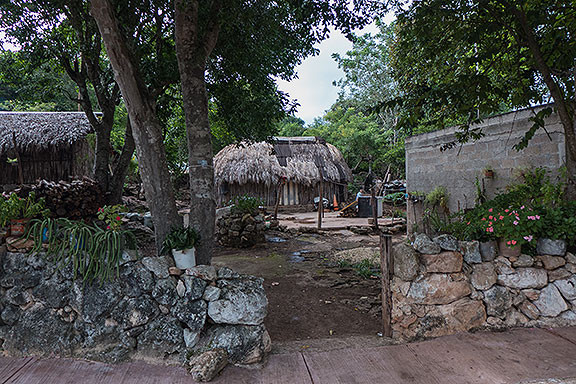
A neighbor’s property with several traditional huts.
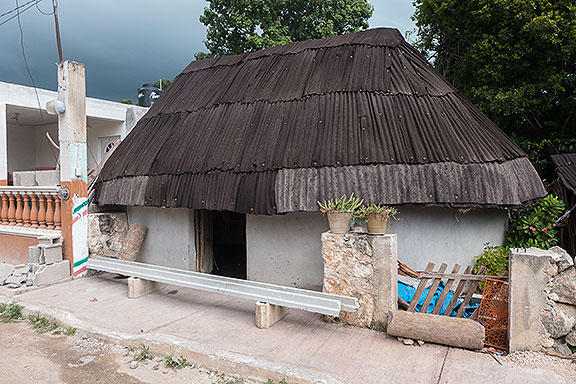
Another neighbor with a partially completed house at left of image, and this traditional hut covered in corrugated sheetmetal.
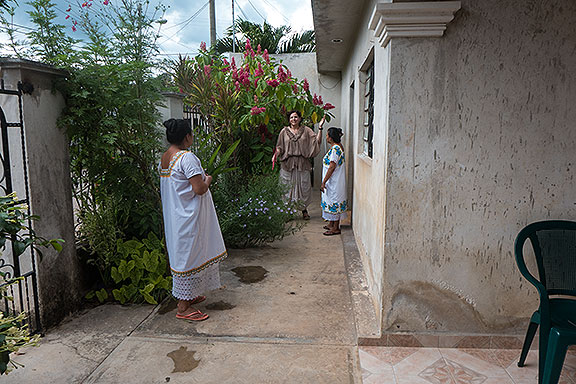
Front yard of one of the Gongora family homes.
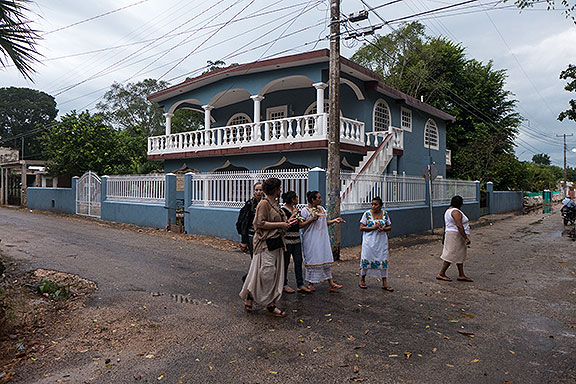
One of Teabo’s wealthier homes, apparently not presently occupied.
The entire Gongora family faces the incomprehensible pain and confusion of losing their loved one in a brutal, unprovoked shooting by the San Francisco police. They lost a man who went north about 16 years ago and by the time the police killed him he was very different than the young guy who left. He has a grandchild who he will never meet, and his children grew up after he left them at a tender age. The determination of the family to get justice for their loved one was unmistakable. But the only course of action beyond pressuring the state for a prosecution (as unlikely as you can imagine due to the Police Officers Association and their political power, and their collective bargaining contract that prevents any serious accountability for officer misconduct) is to seek a civil judgement, i.e. a private investigation to clear Luis’s name from SFPD character assassination, and monetary compensation. San Francisco activists have been fighting to bring the police under public control, so far without success. But if enough monetary losses add up, it may give a political push for the changes needed in the police union contract, and to check their political power. But is it the responsibility of the family in Teabo to push the case if it leaves them more bereft than ever? What if they would prefer to leave the deceased to rest in peace? We will see how the case develops between the family in Teabo, the family in San Francisco, the attorney representing them, and the dynamics of anti-police violence organizing in the City.
These stories are always more complicated than simple black-and-white stories of good vs. evil. Luis and his brother Jose were illegally evicted from their apartment in the Mission of several years and began living on the street around 2014. His local family in San Francisco were able to take in Jose but unable to help Luis. Still, he lived a few blocks away from the home on Shotwell, interacting regularly with them. No one claims he ever hurt anyone or acted aggressively towards anyone. He was considered a kind and honorable man by the people who lived on the sidewalks alongside him, and the local housed neighbors all considered him harmless if perhaps not fully “there.” After the outreach workers called police because they saw a knife (a common, practical implement for daily use and less commonly, self-defense, for those living on the street), the police arrived and within less than 30 seconds shot Luis with beanbag rounds and six of seven bullets. A security camera shows officers unloading the final four shots towards the ground and the autopsy reports (an independent report by the lawyers and the Medical Examiner report) both show that he was hit in the back and then, likely having fallen to the ground, killed with a execution shot to the head showing a steep downward trajectory. (More details at www.justice4luis.org)
No doubt the police felt he was an anonymous homeless man whose death would go unnoticed and unremarked. But instead his story has joined a shamefully growing list of unjustified police murders in what can easily be interpreted as a campaign of class and ethnic cleansing to make way for the new wealthy arrivistes in the Mission. (A recent report documented the arrival of 60,000 new people to San Francisco every year from 2010-2014, and a corresponding departure of the same number—the new arrivals are highly paid, the evicted and displaced are generally poor and working class.)
In a world of profound dislocations, the Gongora family is a microcosm of a much larger dynamic. But the specifics of their story are at the heart of the human experience, and their own family and feelings needs to be foregrounded and honored without subsuming it in any political campaign, abstract ideology, or presumed larger purpose. It is an honor to have been included in this meeting with the family, and to have been welcomed into their home at such a difficult moment. I hope we can help them get the justice they want and deserve.
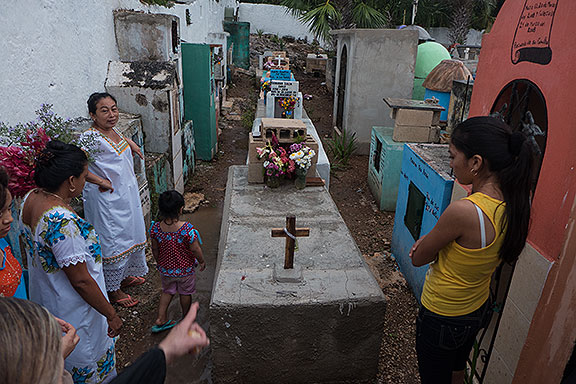
Visiting Luis’s grave in the Teabo cemetery.
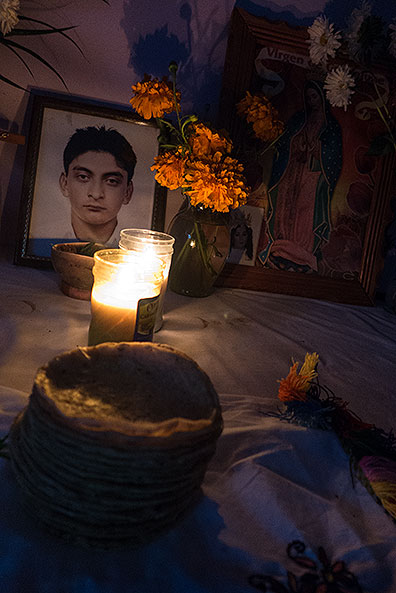
An altar in the house for Day of the Dead.












Leave a Reply